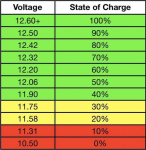So I've been having a handful of electrical issues on my m1008 for the last few weeks and I can't figure it out nore find a solution anywhere.
The biggest issue is starting. Both batteries are around 12v (ones been around 11.8 most the time) but I'm not even getting a crank most the time without jumping both batteries.
I'm getting 24v at the starter, and when I went to hotwire it between the wiring and it cranked without an issue.
Granted the two batteries are both 650cca I believe. Just because I wanted to eliminate my batteries being the problem especially after one of them tested bad. But as soon as I left them on the charger they both went right up to 12.6. but once the trucks starts, my stereo starts turning on and off after a few minutes, then completely shuts off, and I slowly loose accessory power, as well as all nights, blinkers, ect. Even when the batteries are for the most part full.
I have an generator light on. But only one, I think an alternators out but I haven't been able to check it. But unless both alternators are out I can't imagine that's the main issue
If turning the key does anything, it clicks like I don't have enough voltage. But most the time I turn it over only for nothing to happen.
I'm assuming on top of an alternator being out, my ignition switch, or the starters out. But that wouldn't explain the rest of the electrical issues. That's why I'm wondering if a short somewhere would be draining voltage somehow. Or if there's a relay I'm missing. Any advice would be appreciated, thanks
The biggest issue is starting. Both batteries are around 12v (ones been around 11.8 most the time) but I'm not even getting a crank most the time without jumping both batteries.
I'm getting 24v at the starter, and when I went to hotwire it between the wiring and it cranked without an issue.
Granted the two batteries are both 650cca I believe. Just because I wanted to eliminate my batteries being the problem especially after one of them tested bad. But as soon as I left them on the charger they both went right up to 12.6. but once the trucks starts, my stereo starts turning on and off after a few minutes, then completely shuts off, and I slowly loose accessory power, as well as all nights, blinkers, ect. Even when the batteries are for the most part full.
I have an generator light on. But only one, I think an alternators out but I haven't been able to check it. But unless both alternators are out I can't imagine that's the main issue
If turning the key does anything, it clicks like I don't have enough voltage. But most the time I turn it over only for nothing to happen.
I'm assuming on top of an alternator being out, my ignition switch, or the starters out. But that wouldn't explain the rest of the electrical issues. That's why I'm wondering if a short somewhere would be draining voltage somehow. Or if there's a relay I'm missing. Any advice would be appreciated, thanks


